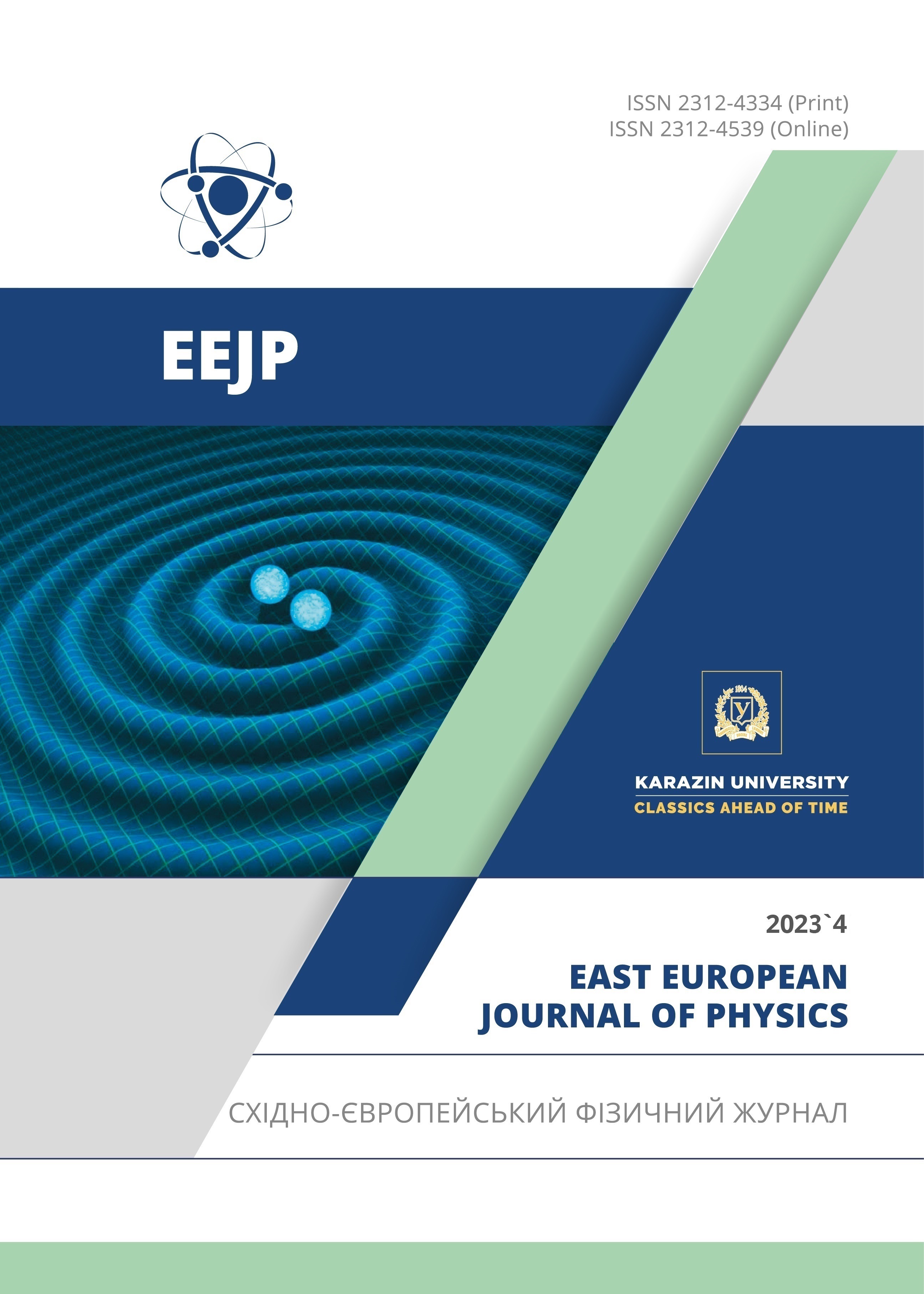To the Theory of Dimensional Quantization in Narrow-Gap Crystals
Abstract
This article discusses studies of size quantization phenomena in zero-, one-, and two-dimensional semiconductor structures. The main attention is paid to the mechanisms of photon-kinetic effects in these structures. Despite many studies of the physical properties of low-dimensional systems of current carriers, the size quantization of energy spectra in narrow-gap semiconductors and the associated photonic-kinetic effects are still insufficiently studied. Therefore, this study focuses on the quantum mechanical study of size quantization in certain cases using Kane's multiband model. The insolvability of the 8×8 matrix Schrödinger equation in the Kane model for a potential well of arbitrary shape is analyzed. The dependence of the energy spectrum on the two-dimensional wave vector is studied for various cases. In particular, the energy spectra for InSb and GaAs semiconductors are considered, depending on the band parameters and the size of the potential well. Conclusions are presented on the analysis of various cases of size quantization in narrow-gap crystals with cubic or tetrahedral symmetry in the three-band approximation. It is shown that the energy spectrum corresponds to a set of size-quantized levels that depend on the Rabi parameter, band gap, and well size. The size-quantized energy spectra of electrons and holes in InSb and GaAs semiconductors are analyzed in a multiband model.
Downloads
References
V.E. Borisenko, and A.I. Vorobyova, Nanoelectronics, Part 2. (BSUIR, Minsk, 2003), p.76. (In Russian).
L.E. Vorobyov, S.N. Danilov, E.L. Ivchenko, I.M. Levinshtein, D.A. Firsov, and V.A. Shalygin, Kinetic and optical phenomena in strong electric fields in semiconductors and nanostructures, (Nauka, St. Petersburg, 2000), p.324. (In Russian).
S.A.Tarasenko, Ph.D. dissertation, St. Petersburg University, 2008. (In Russian).
G. Gulyamov, S.B. Utamuradova, M.G. Dadamirzaev, N.A. Turgunov, M.K. Uktamova, K.M. Fayzullaev, A.I. Khudayberdiyeva, et al., East European Journal of Physics, 2, 221(2023). https://doi.org/10.26565/2312-4334-2023-2-24
Sh.B. Utamuradova, Sh.Kh. Daliev, S.A. Muzafarova, and K.M. Fayzullaev, East European Journal of Physics, 3, 385 (2023). https://doi.org/10.26565/2312-4334-2023-3-41
E.L. Ivchenko, Optical spectroscopy of semiconductor nanostructures, (Alpha Science, Harrow, UK, 2005), p.350.
V.A. Shalygin, Ph.D. dissertation, St. Petersburg University, 2013. (In Russian)
D. Nematov, Kh. Kholmurodov, A. Stanchik, K. Fayzullaev, V. Gnatovskaya, and T. Kudzoev, Trends in Sciences, 20(2), 4058 (2023). https://doi.org/10.48048/tis.2023.4058
S.A. Muzafarova, Sh.B. Utamuradova, A.М. Abdugafurov, K.M. Fayzullaev, E.M. Naurzalieva, and D.A. Rakhmanov, Applied Physics, 4, 81 (2021). https://applphys.orion-ir.ru/appl-21/21-4/PF-21-4-81.pdf (in Russian)
I.A. Akimov, D.N. Mirlin, V.I. Perel, and V.F. Sapega, Semiconductors. 35(6), 1584 (1982). http://journals.ioffe.ru/articles/viewPDF/38563 (in Russian)
V.K. Dugaev, and P.P. Petrov, Semiconductors. 22(3), 519 (1988). http://journals.ioffe.ru/articles/viewPDF/29170 (in Russian)
E.L. Ivchenko, and G.E. Pikus, Superlattices and other heterostructures. Symmetry and optical phenomena, (Springer, Berlin, 1995).
M.M. Glazov, Ph.D. dissertation, St. Petersburg University, 2012. (In Russian).
D. Nematov, Kh. Kholmurodov, A. Stanchik, K. Fayzullaev, V. Gnatovskaya, and T. Kudzoev. Letters in Applied NanoBioScience, 12(3), 67 (2023). https://doi.org/10.33263/LIANBS123.067
G.L. Beer, and G.E. Pikus, Symmetry and deformation effects in semiconductors, (Media, Moskow, 2012), p. 584. (In Russian).
E.L. Ivchenko, and R.Ya. Rasulov. Symmetry and real band structure of semi-conductors, (Fan, Tashkent, 1989). p.126. (In Russian).
I. Vurgaftman, J.R.M. Meyer, and J.R. Ram-Mohan, J. Appl. Phys. 89, 5815 (2001). http://dx.doi.org/10.1063/1.1368156
Copyright (c) 2023 Sharifa B. Utamuradova, Rustam Y. Rasulov, Voxob R. Rasulov, Kamolakhon K. Urinova, Kakhramon M. Fayzullaev

This work is licensed under a Creative Commons Attribution 4.0 International License.
Authors who publish with this journal agree to the following terms:
- Authors retain copyright and grant the journal right of first publication with the work simultaneously licensed under a Creative Commons Attribution License that allows others to share the work with an acknowledgment of the work's authorship and initial publication in this journal.
- Authors are able to enter into separate, additional contractual arrangements for the non-exclusive distribution of the journal's published version of the work (e.g., post it to an institutional repository or publish it in a book), with an acknowledgment of its initial publication in this journal.
- Authors are permitted and encouraged to post their work online (e.g., in institutional repositories or on their website) prior to and during the submission process, as it can lead to productive exchanges, as well as earlier and greater citation of published work (See The Effect of Open Access).








